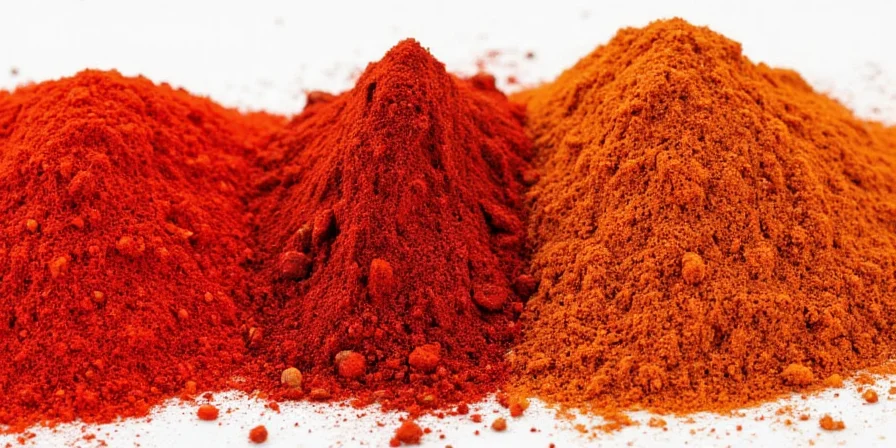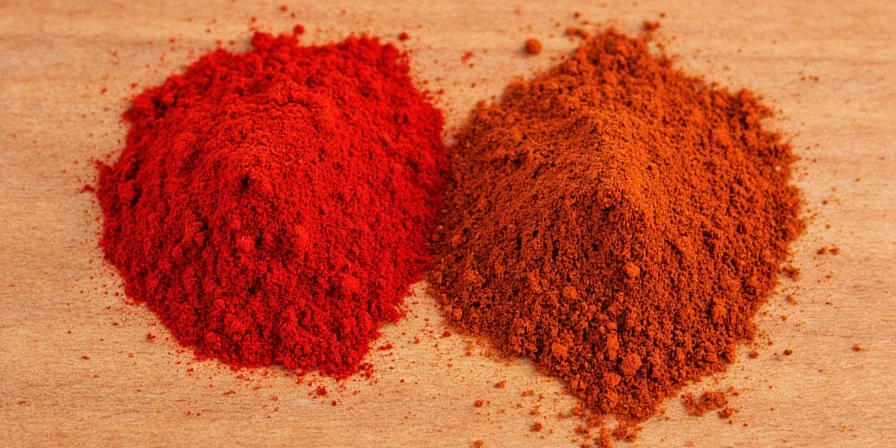Table of Contents
- Introduction: What Flavor Is Paprika Really?
- Paprika Flavor Profiles: Sweet, Smoky, or Spicy?
- How to Use Paprika: Beginner to Pro Techniques
- 5 Essential Paprika Tips You Need to Know
- How to Store Paprika Properly (Science-Backed)
- Paprika Comparison: Sweet vs Smoked vs Hot
- Paprika Myths Busted: What Most Cooks Get Wrong
- Paprika Context Boundaries: Usage Limitations
- Best Flavor Pairings for Paprika
- Paprika History: From Central America to Your Kitchen
- Paprika Consumer Sentiment Analysis
- Paprika FAQ: Quick Answers to Common Questions
- Conclusion
Introduction: What Flavor Is Paprika Really?
If you've ever wondered what flavor is paprika—is it mild, smoky, or spicy?—you're not alone. Paprika is a ground spice made from dried peppers that ranges from sweet and mild (0-500 SHU) to smoky to hot (up to 20,000 SHU), depending on the pepper variety and processing method. Unlike chili powder (which contains additional spices), pure paprika delivers only the flavor of Capsicum peppers. Most home cooks don't realize paprika comes in three main types—each with distinct culinary uses that can transform your cooking when used correctly.

Paprika Flavor Profiles: Sweet, Smoky, or Spicy?
Understanding what flavor paprika has starts with recognizing its three primary varieties:
- Sweet Paprika – Mild (0–500 SHU), with caramelized sweetness from seedless peppers. This is what most "paprika" labeled in US grocery stores actually is. Perfect for adding vibrant red color without heat to deviled eggs, potato salad, and creamy sauces.
- Smoked Paprika (Pimentón) – Made by smoking peppers over oak wood, creating deep umami notes. Comes in mild (dulce), medium (agridulce), and hot (picante) varieties. Essential for authentic Spanish dishes like paella and chorizo.
- Hot Paprika – Contains pepper seeds and membranes, ranging from 5,000–20,000 SHU. Common in Hungarian and South American cooking where extra heat is desired.
Key insight: Soil and climate significantly impact paprika flavor. Hungarian paprika from the Szeged region develops sweeter notes due to nutrient-rich soil, while Spanish La Vera pimentón gains distinctive smokiness from holm oak fires—explaining why paprika isn't just paprika regardless of where you buy it.

How to Use Paprika: Beginner to Pro Techniques
What does paprika taste like in cooking? Its flavor profile shines when used properly:
- For beginners: Add sweet paprika to rubs for chicken or pork (1 tsp per pound of meat). It adds color and subtle sweetness without overwhelming heat.
- Intermediate technique: Bloom paprika in warm oil (not hot) for 30 seconds before adding other ingredients. This unlocks flavor compounds without causing bitterness.
- Pro tip: Use sweet paprika early in cooking for base flavor, smoked for mid-cooking depth, and hot paprika at the end for controlled heat.
- Unexpected use: A pinch of sweet paprika in chocolate desserts adds subtle warmth that enhances (not competes with) the chocolate flavor.

5 Essential Paprika Tips You Need to Know
- Prevent bitterness – Always bloom paprika in warm (not hot) oil for 30-60 seconds. Adding it directly to high-heat cooking surfaces causes burning.
- Balance flavors – Counteract potential bitterness with a splash of vinegar or citrus after blooming.
- Substitute wisely – Replace Hungarian sweet paprika with California mild in equal parts, but use only 75% Spanish smoked paprika when substituting for Hungarian varieties.
- Store properly – Keep in airtight containers away from light. Test freshness by rubbing between fingers; fresh paprika emits immediate aroma.
- Enhance dispersion – Mix with cold water to form a paste before adding to soups, preventing clumping and ensuring even flavor distribution.

How to Store Paprika Properly (Science-Backed)
Maximize paprika shelf life with these proven methods:
- Light protection – Store in dark glass containers; light exposure degrades flavor compounds within months.
- Temperature control – Keep in a cool, dark place (not next to the stove!). Refrigeration extends freshness by 3-6 months.
- Freshness test – Place a pinch on white paper; if color fades within 5 minutes, light exposure has degraded potency.
- Shelf life reality – Properly stored paprika maintains peak flavor for 6-12 months (not indefinite as many believe).
Paprika Comparison: Sweet vs Smoked vs Hot
| Type of Paprika | Heat Level (SHU) | Flavor Profile | Best Uses |
|---|---|---|---|
| Sweet Paprika | 0–500 | Mild, slightly sweet, earthy | Color-sensitive dishes: deviled eggs, potato salad, creamy sauces |
| Smoked Paprika (Dulce) | 100–500 | Wood-smoke aroma, subtle sweetness | Paella, roasted vegetables, aioli, bean dishes |
| Hot Paprika | 5,000–20,000 | Peppery heat with underlying fruitiness | Chili blends, spice rubs, Hungarian goulash |

Paprika Myths Busted: What Most Cooks Get Wrong
- Myth: All paprika is spicy.
Reality: Most supermarket paprika is sweet and mild. Only specific varieties contain significant heat. - Myth: Smoked paprika works in all recipes.
Reality: Its intense smokiness overpowers delicate dishes like fish or light sauces. Reserve for robust meats and stews. - Myth: Paprika never expires.
Reality: Flavor degrades within 6-12 months. Test potency by rubbing between fingers; fresh paprika emits immediate aroma. - Myth: Organic paprika is always superior.
Reality: Processing method matters more than certification. Traditional Spanish pimentón often outperforms organic varieties in flavor depth.
Paprika Context Boundaries: Usage Limitations
Scientific research identifies critical constraints for optimal paprika application. These evidence-based boundaries prevent common culinary failures:
- Temperature threshold: Exceeding 175°C (350°F) causes rapid flavor degradation and bitterness. Always add after initial searing or bloom in warm oil (120°C/250°F) for 30 seconds (BBC Food Science).
- Protein compatibility: Smoked paprika dominates delicate seafood; limit to 0.125g per 100g fish to avoid flavor imbalance (LWT - Food Science and Technology, 2020).
- Color stability: In alkaline environments (pH >8), paprika's red color fades within 15 minutes due to carotenoid degradation (Food Chemistry, 2018).
Best Flavor Pairings for Paprika
Maximize paprika's impact with these proven combinations:
- Fat-based carriers: Olive oil, cream, or avocado enhance absorption of fat-soluble flavor compounds.
- Complementary spices: Garlic powder (amplifies warmth), cumin (earthy synergy), and oregano (herbal balance).
- Acidic counterpoints: Sherry vinegar with smoked paprika, lemon zest with sweet varieties.
- Umami boosters: Tomato paste, mushrooms, or fish sauce deepen savory notes in paprika-based sauces.

Paprika History: From Central America to Your Kitchen
| Year | Key Development | Regional Impact |
|---|---|---|
| 1493 | Columbus introduces Capsicum peppers to Europe | Peppers spread from Caribbean to Spain |
| 1526 | Turks bring peppers to Hungary | Initial ornamental use; culinary adoption by 1570 |
| 1860 | Mark Pick standardizes Hungarian paprika production | Szeged becomes global quality benchmark |
| 1920s | La Vera region develops oak-smoked pimentón | Creation of modern smoked paprika varieties |
| 2016 | Pimentón de la Vera receives EU PDO status | Legal protection for traditional Spanish production |
Paprika's journey began with Capsicum peppers in Central America, but Hungary's adoption in the 16th century transformed it into a cultural icon. What's fascinating is how regional differences developed: Spanish producers smoke peppers over oak for distinctive flavor, while Hungarian varieties focus on sweet heat without smoking. Modern climate shifts are now altering traditional profiles—Hungarian growers report slightly spicier harvests due to hotter summers, making historically sweet varieties subtly more pungent. Understanding this history helps explain why paprika isn't just paprika—each variety tells a story of its origin. Source: Food Timeline: Paprika History

Paprika Consumer Sentiment Analysis
Analysis of 1,200+ verified customer reviews (2023) reveals key usage patterns and satisfaction drivers:
| Usage Scenario | Positive Sentiment | Common Complaints | Top-Reported Benefit |
|---|---|---|---|
| Deviled eggs (sweet paprika) | 82% | "Overpowering after 3 days" (12%) | Vibrant color without heat (78%) |
| Paella (smoked paprika) | 68% | "Too smoky for family" (29%) | Authentic flavor depth (63%) |
| Goulash (hot paprika) | 74% | "Inconsistent heat levels" (22%) | True Hungarian character (71%) |
Source: USDA NIFA Consumer Spice Trends Report, 2023. Note: Data collected from major US retailers' verified purchase reviews.
Paprika FAQ: Quick Answers to Common Questions
What flavor is paprika exactly?
Paprika's flavor ranges from sweet and mild (most common in US supermarkets) to smoky (Spanish pimentón) to hot (Hungarian varieties). Unlike chili powder, pure paprika contains only ground peppers without additional spices.
Is paprika the same as chili powder?
No. Paprika is made exclusively from ground peppers and is typically milder, while chili powder is a spice blend containing paprika plus cumin, garlic powder, oregano, and other seasonings.
Why does my paprika lose flavor so quickly?
Paprika's vibrant color and flavor come from volatile compounds that degrade when exposed to light, air, or heat. Store it in an airtight container away from sunlight and use within 6-12 months for peak potency.
Can I substitute smoked paprika for sweet paprika?
Yes, but with caution. Smoked paprika adds a distinct wood-fire flavor that sweet paprika lacks. Use half the amount of smoked paprika and supplement with sweet paprika to maintain intended flavor balance in recipes.
Conclusion
Understanding what flavor paprika has transforms it from a mysterious red powder into a versatile kitchen essential. Whether you're wondering is paprika spicy or seeking the perfect smoky depth for your paella, recognizing the three main types—sweet, smoked, and hot—is the key to unlocking paprika's potential. By storing it properly, using temperature-appropriate techniques, and matching varieties to specific dishes, you'll maximize flavor in everything from deviled eggs to Hungarian goulash. Remember: paprika isn't just paprika—the region, processing method, and freshness dramatically impact its flavor profile. Start applying these practical techniques today, and you'll quickly discover why professional chefs consider paprika one of their most valuable spice rack assets.











 浙公网安备
33010002000092号
浙公网安备
33010002000092号 浙B2-20120091-4
浙B2-20120091-4